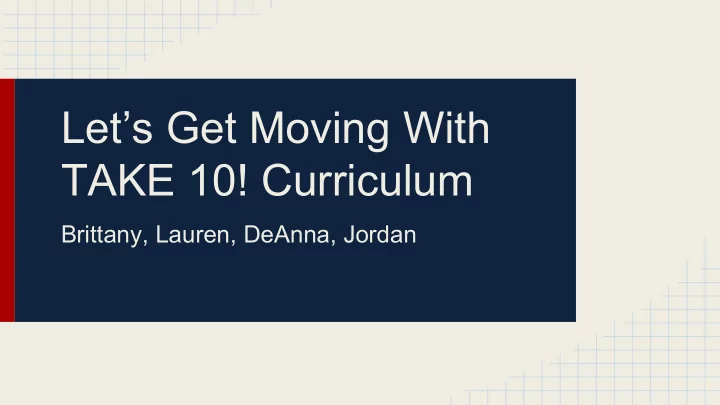

Let’s Get Moving With TAKE 10! Curriculum Brittany, Lauren, DeAnna, Jordan
What’s Going On In Schools? ➢ Are your student’s dozing off in class? ➢ Are they having difficulty focusing? ➢ Do they act out because of boredom? ➢ Maybe they just need some movement in their life!
Why do Students Need More Physical Activity? ● Over the past 30 years, obesity rates have doubled in children and quadrupled in adolescents ● In 2012 over ⅓ of children and adolescents were overweight or obese ● Obese youth are at higher risk for cardiovascular disease, pre diabetes, bone and joint problems, sleep apnea, types of cancer, poor self esteem, and other social and psychological problems Centers for Disease Control and Prevention. (March 12, 2014). Adolescent and school health. Retrieved from http://www.cdc.gov/healthyyouth/obesity/facts.htm
Current Level of Activity ● The CDC recommends 60 minutes of activity/day for children and adolescents, that equals 420 minutes/week ● Our school currently has 30 minutes of recess, 5 days a week and 60 minutes of PE, once a week, totaling 210 minutes of 420 min (recommended) activity per week - 210 min (current) --------------------------------------- ● That leaves 210 minutes per week , or 42 210 min (unaccounted for) minutes per day, that children must account for outside of school Night, N. (2014). Moving and learning all day . [PowerPoint slides].
What Will Movement Do? There are numerous benefits of physical activity! Improved physical fitness ❏ ❏ Reduced stress Weight managment ❏ Improved cooperation skills ❏ Feelings of success ❏ ❏ Heightened state of attention Improved academic performance ❏ Improved learning, memory, mood ❏ and behavior Wajciechowski, M. (2014). Day 1 Power Point Waj . [PowerPoint slides]. Retrieved from https://blackboard.vcu.edu/ Ratey, J. J., & Hagerman, E. (2008). Spark: The revolutionary new science of exercise and the brain . New York: Little, Brown.
TAKE 10! Curriculum What’s It All About? ● TAKE 10! emphasizes active learning by combining academics with 10 minute physical activity lessons ● All activities are linked to academic learning objectives ● Positive health messages are incorporated throughout the activities/lessons
TAKE 10! Curriculum So What Do You Have To Do? ➔ Include one or more TAKE 10! activities that reinforce learning objectives each day ➔ Use the activities to break-up long blocks, transition students to next subject, and de-stress and refocus students ➔ Display TAKE 10! poster and stickers to track your activities
Why do WE need TAKE10! ? ● Three TAKE 10! lessons incorporated into the school day can make up for 150 unaccounted minutes, leaving children responsible for only 12 minutes per day outside of school ● When teachers start to see the benefits of movement and exercise in the classroom, 420 min (recommended) they may continue look for opportunities to - 360 min (proposed) incorporate movement at help make up for --------------------------------------- the remaining 60 minutes (brain breaks, 60 min (unaccounted for) review activities, warm ups for quizzes, etc)
Year-At-A-Glance Example of First 9 Weeks ● First 9 Weeks: slowly add active Week Number Active Lessons lessons into the weekly schedule, (per week) ending the period with four active 1 1 lessons per week ● Second 9 Weeks: five active lessons 2 1 per week (one per day) 3 2 ● Third 9 Weeks: ten active lessons per 4 2 week (two per day) ● Fourth 9 Weeks: fifteen active lessons 5 3 per week (three per day) 6 3 ● All subjects should be covered throughout the week, with spare days 7 4 spent on more difficult subjects 8 4 9 4
Implementation: Ideal Week-At-A-Glance Monday Tuesday Wednesday Thursday Friday (8:30-8:45 morning routine) Language Arts Language Arts Language Arts Language Arts Language Arts 8:45-10:00am * TAKE 10! *TAKE 10! *TAKE 10! *TAKE 10! *TAKE 10! 10:00-11:00am Science Science Science Science Science 11:00-11:30am Lunch Lunch Lunch Lunch Lunch Recess Recess Recess Recess Recess 11:30-12:00pm 12:00-1:15pm Math Math Math Math Math *TAKE 10! *TAKE 10! *TAKE 10! *TAKE 10! *TAKE 10! 1:15-2:15 Art Music P.E. Library Computers 2:15-3:15pm *TAKE 10! *TAKE 10! *TAKE 10! *TAKE 10! *TAKE 10! (3:15-3:30 pack up) Social Studies Social Studies Social Studies Social Studies Social Studies
References Centers for Disease Control and Prevention. (2014). Adolescent and school health. Retrieved from http://www.cdc.gov/healthyyouth/obesity/facts.htm Night, N. (2014). Moving and learning all day . [PowerPoint slides]. Ratey, J. J., & Hagerman, E. (2008). Spark: The revolutionary new science of exercise and the brain . New York: Little, Brown. Wajciechowski, M. (2014). Day 1 power point Waj . [PowerPoint slides]. Retrieved from https://blackboard.vcu.edu/webapps/portal/frameset.jsp?tab_group=courses&url=%2Fwebapps%2Fblackboard%2Fexe cute%2Fcontent%2Ffile%3Fcmd%3Dview%26content_id%3D_4822494_1%26course_id%3D_119521_1%26frameset Wrapped%3Dtrue
Recommend
More recommend